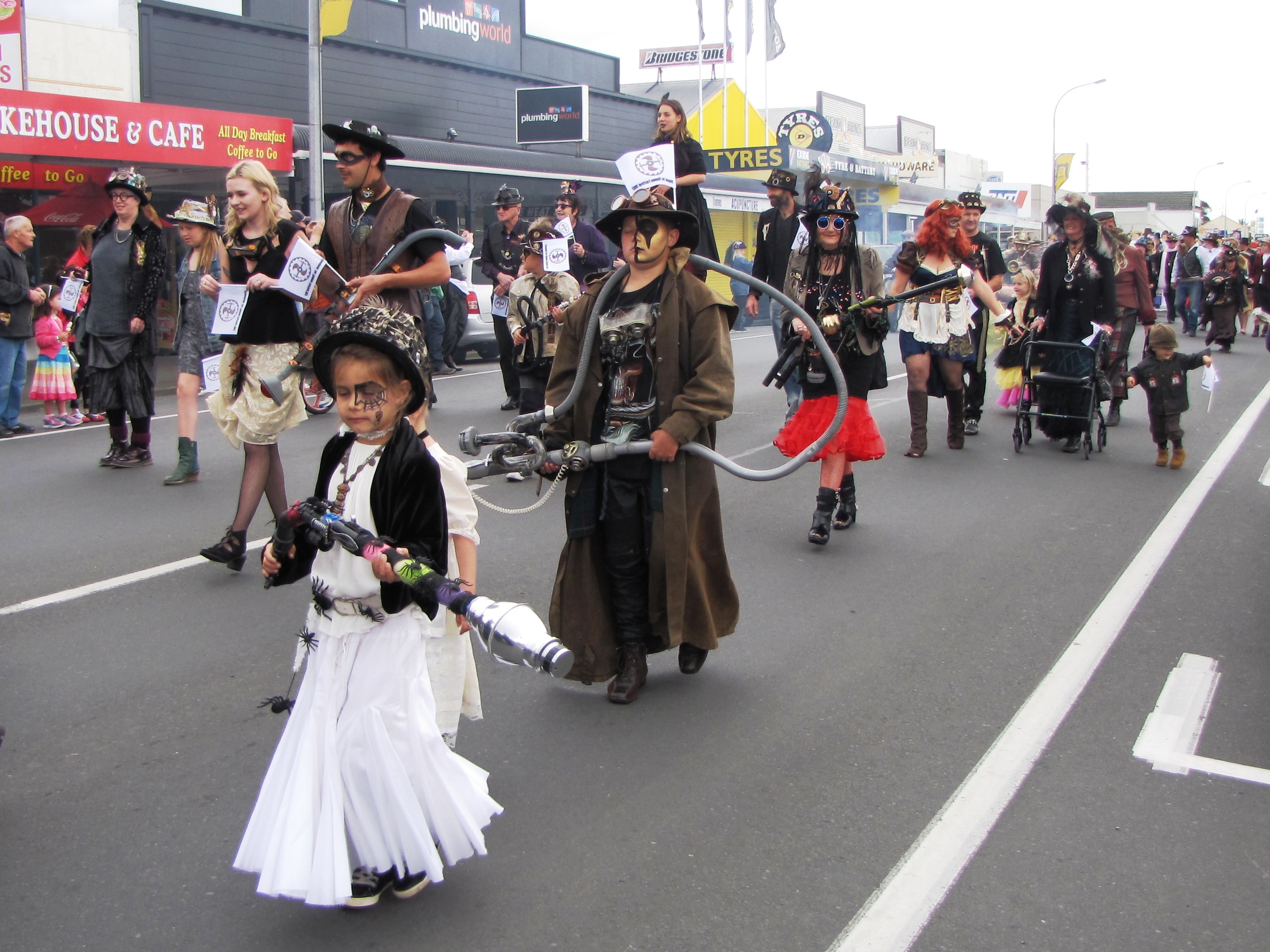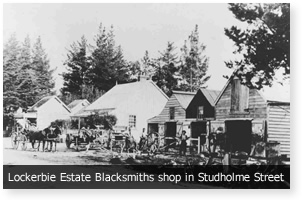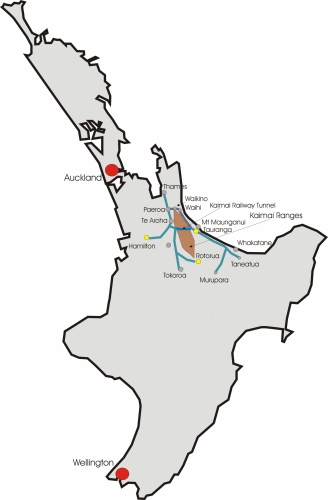|
Thames Railway Station
The Thames railway station is a former railway station in Thames, New Zealand on the former Thames Branch from Morrinsville to Thames. The station opened on 19 December 1898 with the opening of the branch line. Passenger service ceased from 28 March 1951. There were also station buildings at Thames North and Thames South. The branch was closed (apart from a section) on 28 June 1991, and goods service ceased. However the station building remained as it was listed by NZHPT Category II in 1982. It is a standard Vintage station, with gables, finials and scalloped bargeboards. Work on the proposed Paeroa–Pokeno Line commenced in the 1930s, but little was done and the proposal was abandoned. The line was to be the first part of the East Coast Main Trunk The East Coast Main Trunk (ECMT) is a railway line in the North Island of New Zealand, originally running between Hamilton and Taneatua via Tauranga, connecting the Waikato with the Bay of Plenty. The ECMT now runs betwe ... [...More Info...] [...Related Items...] OR: [Wikipedia] [Google] [Baidu] |
Thames Branch
The Thames Branch railway line connected Thames, New Zealand, with Hamilton and was originally part of the East Coast Main Trunk railway. Part of the line between Morrinsville and Waitoa remains open and is in use as the Waitoa Branch line, connecting to the Fonterra Dairy Factory at Waitoa. History The discovery of gold in the Thames area in 1852 provided the impetus for building a railway line from Auckland to Thames. In 1872 the Auckland Provincial Council recommended a rail connection to Thames, primarily due to issues associated with barging coal from North Auckland coal mines to Thames to serve the gold mining industry. Surveys were completed in 1878, despite opposition from local Maori, putting the cost of the 54 km line at £178,000. The Thames-Te Aroha section had cost £159,340 (about $30m in 2018 values) when opened. Premier Sir George Grey turned the first sod of the line at Thames on 21 December 1878, but 18 months later work from Thames was stopped by the ... [...More Info...] [...Related Items...] OR: [Wikipedia] [Google] [Baidu] |
Thames, New Zealand
Thames () ( mi, Pārāwai) is a town at the southwestern end of the Coromandel Peninsula in New Zealand's North Island. It is located on the Firth of Thames close to the mouth of the Waihou River. The town is the seat of the Thames-Coromandel (district), New Zealand, Thames-Coromandel District Council. The Māori people, Māori iwi are Ngāti Maru (Hauraki), Ngāti Maru, who are descendants of Marutuahu's son Te Ngako. Ngāti Maru is part of the Ngati Marutuahu confederation of tribes or better known as Hauraki Iwi. Thames had an estimated population of 15,000 in 1870, but this declined to 4,500 in 1881, and it has increased modestly since. It is still the biggest town on the Coromandel. Until 2016, a historical Oak, oak tree that was planted by Governor George Grey stood on the corner of Grey and Rolleston streets. Demographics Thames covers and had an estimated population of as of with a population density of people per km2. Thames had a population of 7,293 at the 2018 Ne ... [...More Info...] [...Related Items...] OR: [Wikipedia] [Google] [Baidu] |
Morrinsville
Morrinsville is a provincial town in the Waikato region of New Zealand's North Island, with an estimated population of as of The town is located at the northern base of the Pakaroa Range, and on the south-western fringe of the Hauraki Plains. Morrinsville is around 33 kilometres east of Hamilton and 22 kilometres west of Te Aroha. The town is bordered by the Piako River to the east and the Waitakaruru Stream to the south. History and Culture Pre-European settlement Prior to European settlement of New Zealand, the hills around present-day Morrinsville were occupied by the Ngati Werewere Māori people of the Ngati Haua Iwi, and the site of the present-day town was on or near to an old Māori route between the upper Waihou-Piako basin and the Ngāruawāhia area. Following European settlement, some early European traders are believed to have traversed this route prior to 1834 when the Rev. J. Morgan travelled up the Piako River to near the future town site and crossed west ... [...More Info...] [...Related Items...] OR: [Wikipedia] [Google] [Baidu] |
Heritage New Zealand
Heritage New Zealand Pouhere Taonga (initially the National Historic Places Trust and then, from 1963 to 2014, the New Zealand Historic Places Trust) ( mi, Pouhere Taonga) is a Crown entity with a membership of around 20,000 people that advocates for the protection of ancestral sites and heritage buildings in New Zealand. It was set up through the Historic Places Act 1954 with a mission to "...promote the identification, protection, preservation and conservation of the historical and cultural heritage of New Zealand" and is an autonomous Crown entity. Its current enabling legislation is the Heritage New Zealand Pouhere Taonga Act 2014. History Charles Bathurst, 1st Viscount Bledisloe gifted the site where the Treaty of Waitangi was signed to the nation in 1932. The subsequent administration through the Waitangi Trust is sometimes seen as the beginning of formal heritage protection in New Zealand. Public discussion about heritage protection occurred in 1940 in conjunction with t ... [...More Info...] [...Related Items...] OR: [Wikipedia] [Google] [Baidu] |
George Troup (architect)
Sir George Alexander Troup (21 October 1863 – 4 October 1941) was a New Zealand architect, engineer and statesman. He was nicknamed "Gingerbread George" after his most famous design, the Dunedin Railway Station in the Flemish Renaissance style (he preferred his alternative design in the Scottish Baronial style). He was the first official architect of the New Zealand Railways. He designed many other stations, including Lower Hutt and Petone. Early life and education He was born in London, England. His family returned to Edinburgh, Scotland soon after he was born. His widowed mother sent him to Robert Gordon's College, Aberdeen, where he was entitled to free board and tuition as the son of an Aberdeen burgess. He trained as an architect and engineer under C.E. Calvert in Edinburgh, and in 1882 was employed as a draughtsman by architect J.J.A. Chesser. Career He emigrated to New Zealand in 1884. Joining the Survey Department when he arrived in Dunedin, he worked in remote sur ... [...More Info...] [...Related Items...] OR: [Wikipedia] [Google] [Baidu] |
Paeroa–Pokeno Line
The Paeroa-Pokeno railway line or deviation in the upper North Island of New Zealand between Paeroa on the East Coast Main Trunk (ECMT) and Pokeno on the North Island Main Trunk (NIMT) was a proposed route with construction started but abandoned. The proposal has been revived in recent years as part of a more direct route between Auckland and Tauranga. History A request for the line was made in 1905 and a route surveyed in 1926. Proposals were also made to shorten the route by a further , by starting it at Manurewa railway station, Manurewa and serving Hunua. Work started in 1938 on the line, which would have shortened the distance from Auckland to towns on the ECMT by . Minister of Public Works, Bob Semple, turned the first sod on 27 January 1938 at Paeroa railway station, Paeroa and about of the line had been started when work was abandoned in 1940. Work was still making slow progress in 1950, when a paragraph in the New Zealand Ministry of Works, Ministry of Works annual ... [...More Info...] [...Related Items...] OR: [Wikipedia] [Google] [Baidu] |
East Coast Main Trunk
The East Coast Main Trunk (ECMT) is a railway line in the North Island of New Zealand, originally running between Hamilton and Taneatua via Tauranga, connecting the Waikato with the Bay of Plenty. The ECMT now runs between Hamilton and Kawerau, with a branch line to Taneatua from the junction at Hawkens. The line is built to narrow gauge of , the uniform gauge in New Zealand. It was known as the East Coast Main Trunk Railway until 2011, when the word "Railway" was dropped. History Construction In 1880, the North Island Main Trunk railway had reached Frankton, Hamilton, from Auckland. From there, it was delayed by construction of the original Waikato River bridge (now carrying road traffic as part of Claudelands Road), before the line made its way to Morrinsville in October 1884, Te Aroha in March 1886 and Paeroa in 1898. There were also minor delays, such as in the delivery of totara sleepers. The route to Waihi through the Karangahake Gorge was surveyed in the next few year ... [...More Info...] [...Related Items...] OR: [Wikipedia] [Google] [Baidu] |
Defunct Railway Stations In New Zealand
{{Disambiguation ...
Defunct (no longer in use or active) may refer to: * ''Defunct'' (video game), 2014 * Zombie process or defunct process, in Unix-like operating systems See also * * :Former entities * End-of-life product * Obsolescence Obsolescence is the state of being which occurs when an object, service, or practice is no longer maintained or required even though it may still be in good working order. It usually happens when something that is more efficient or less risky r ... [...More Info...] [...Related Items...] OR: [Wikipedia] [Google] [Baidu] |
Heritage New Zealand Category 2 Historic Places In Waikato
Heritage may refer to: History and society * A heritage asset is a preexisting thing of value today ** Cultural heritage is created by humans ** Natural heritage is not * Heritage language Biology * Heredity, biological inheritance of physical characteristics * Kinship, the relationship between entities that share a genealogical origin Arts and media Music * ''Heritage'' (Earth, Wind & Fire album), 1990 * ''Heritage'' (Eddie Henderson album), 1976 * ''Heritage'' (Opeth album), 2011, and the title song * Heritage Records (England), a British independent record label * Heritage (song), a 1990 song by Earth, Wind & Fire Other uses in arts and media * ''Heritage'' (1935 film), a 1935 Australian film directed by Charles Chauvel * ''Heritage'' (1984 film), a 1984 Slovenian film directed by Matjaž Klopčič * ''Heritage'' (2019 film), a 2019 Cameroonian film by Yolande Welimoum * ''Heritage'' (novel), a ''Doctor Who'' novel Organizations Political parties * Heritage (Armenia) ... [...More Info...] [...Related Items...] OR: [Wikipedia] [Google] [Baidu] |
Thames-Coromandel District
The Thames-Coromandel District is a territorial authority district in the North Island of New Zealand, covering all the Coromandel Peninsula and extending south to Hikutaia. It is administered by the Thames-Coromandel District Council, which has its seat in the town of Thames. It was the first district council to be formed in New Zealand, being constituted in 1975. The district lies within the Waikato Regional Council area. Its only land boundary is with Hauraki District. Demographics The district had a population of live in Thames, in Whitianga, in Whangamatā, and in Coromandel. Thames-Coromandel District covers and had an estimated population of as of with a population density of people per km2. Thames-Coromandel District had a population of 29,895 at the 2018 New Zealand census, an increase of 3,717 people (14.2%) since the 2013 census, and an increase of 3,957 people (15.3%) since the 2006 census. There were 12,471 households, comprising 14,625 males and 15,27 ... [...More Info...] [...Related Items...] OR: [Wikipedia] [Google] [Baidu] |
Rail Transport In Waikato
Rail or rails may refer to: Rail transport *Rail transport and related matters *Rail (rail transport) or railway lines, the running surface of a railway Arts and media Film * ''Rails'' (film), a 1929 Italian film by Mario Camerini * ''Rail'' (1967 film), a film by Geoffrey Jones for British Transport Films *'' Mirattu'' or ''Rail'', a Tamil-language film and its Telugu dub Magazines * ''Rail'' (magazine), a British rail transport periodical * ''Rails'' (magazine), a former New Zealand based rail transport periodical Other arts *The Rails, a British folk-rock band * Rail (theater) or batten, a pipe from which lighting, scenery, or curtains are hung Technology *Rails framework or Ruby on Rails, a web application framework *Rail system (firearms), a mounting system for firearm attachments *Front engine dragster *Runway alignment indicator lights, a configuration of an approach lighting system *Rule Augmented Interconnect Layout, a specification for expressing guidelines for prin ... [...More Info...] [...Related Items...] OR: [Wikipedia] [Google] [Baidu] |
Buildings And Structures In Waikato
A building, or edifice, is an enclosed structure with a roof and walls standing more or less permanently in one place, such as a house or factory (although there's also portable buildings). Buildings come in a variety of sizes, shapes, and functions, and have been adapted throughout history for a wide number of factors, from building materials available, to weather conditions, land prices, ground conditions, specific uses, prestige, and aesthetic reasons. To better understand the term ''building'' compare the list of nonbuilding structures. Buildings serve several societal needs – primarily as shelter from weather, security, living space, privacy, to store belongings, and to comfortably live and work. A building as a shelter represents a physical division of the human habitat (a place of comfort and safety) and the ''outside'' (a place that at times may be harsh and harmful). Ever since the first cave paintings, buildings have also become objects or canvasses of much artistic ... [...More Info...] [...Related Items...] OR: [Wikipedia] [Google] [Baidu] |





